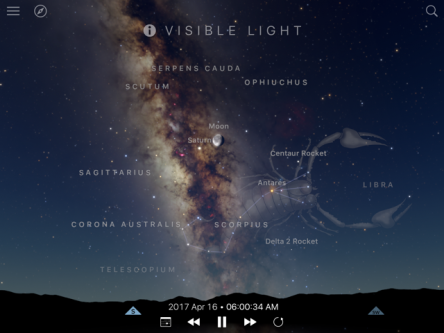
SPECIAL OBSERVING ANNOUNCEMENT: Comet C/2017 E4 ( Lovejoy ) was discovered by Terry Lovejoy on March 10th, 2017 and has begun brightening better than expected. At the time of this writing it had reached a brightness of +7-7.5 and may peak at a magnitude of +6 (making it a naked eye comet under dark sky conditions). The comet can be seen in our eastern sky at dawn during the first week of April with a pair of 10X50 binoculars or a small telescope. It is suggested that you visit web sites such as Sky & Telescope for up to the minute details as to its current progress and location. http://www.skyandtelescope.com

• Apr 1 – The planet Mercury is at its highest point in our sky for the year. Look for it just above the western horizon right after sunset.
• Apr 3 -The moon is at first quarter.

Apr 6 – The waxing gibbous moon lies just one degree south of the star Regulus, alpha star in the constellation of Leo.
Apr 7 – The planet Jupiter is at opposition. When a planet is at opposition it is in a place within its orbit such that the Sun, the Earth, and the planet are all aligned in a straight line with the Earth positioned in the center. At opposition a planet is visible all night and at its brightest, in other words it is at its prime for viewing.

Apr 10 – Look for a near full moon to form a triangle with Jupiter and Spica, the alpha star in the constellation of Virgo.
• Apr 11 – Full moon occurs at 1:08 AM CDT.
• Apr 15 –The moon is at apogee (the furthest from the Earth), 251,950 miles, at 5:05 AM CDT

• Apr 16 – During the early morning look for the planet Saturn just 5 degrees below and to the lower left of a waning gibbous moon.
Apr 22 – The peak of the Lyrid meteor shower occurs during the hours before dawn. The Lyrids are usually weak with about 12-20 meteors per hour seen under dark sky conditions. There have been occasional outbursts associated with the Lyrids, the last being in 1982 when rates jumped to 90 per hour. The moon will not interfere with the Lyrids this year.

• Apr 23 – A waning crescent moon is visible just 8 degrees to the right of the planet Venus in the early morning hours before sunrise.
• Apr 26 – New moon occurs at 7:16 AM CDT.
• Apr 27 – The moon is at perigee (the closest to Earth), 223,275 miles, at 11:15 PM CDT.
• Apr 29 – Venus shines at its brightest (magnitude of -4.7) during the early morning hours before sunrise.